Related Research Articles

Maasai Mara, also sometimes spelled Masai Mara and locally known simply as The Mara, is a large national game reserve in Narok, Kenya, contiguous with the Serengeti National Park in Tanzania. It is named in honour of the Maasai people, the ancestral inhabitants of the area, who migrated to the area from the Nile Basin. Their description of the area when looked at from afar: "Mara" means "spotted" in the local Maasai language, due to the many short bushy trees which dot the landscape.
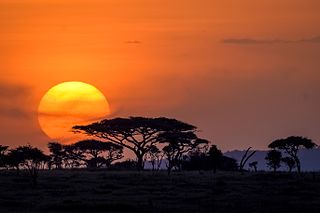
The Serengeti ecosystem is a geographical region in Africa, spanning the Mara and Arusha Regions of Tanzania. The protected area within the region includes approximately 30,000 km2 (12,000 sq mi) of land, including the Serengeti National Park and several game reserves. The Serengeti hosts the second largest terrestrial mammal migration in the world, which helps secure it as one of the Seven Natural Wonders of Africa.
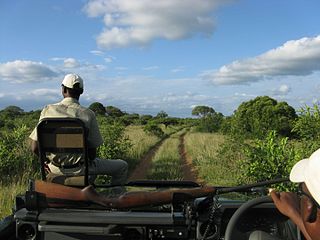
Phinda Private Game Reserve, formerly known as Phinda Resource Reserve, is a 170 km2 (66 sq mi) private game reserve situated in KwaZulu-Natal, South Africa, between the Mkuze Game Reserve and the Greater St. Lucia Wetland Park. Designated in 1990, Phinda is derived from a Zulu phrase "Phinda Izilwane" meaning 'return of wildlife', or more accurately 'do again'.
Amboseli National Park, formerly Maasai Amboseli Game Reserve, is a national park in Kajiado South Constituency in Kajiado County, Kenya. It is 39,206 ha (392.06 km2) in size at the core of an 8,000 km2 (3,100 sq mi) ecosystem that spreads across the Kenya-Tanzania border. The local people are mainly Maasai, but people from other parts of the country have settled there attracted by the successful tourist-driven economy and intensive agriculture along the system of swamps that makes this low-rainfall area, average 350 mm (14 in), one of the best wildlife-viewing experiences in the world with 400 species of birds including water birds like pelicans, kingfishers, crakes, hamerkop and 47 raptor species.
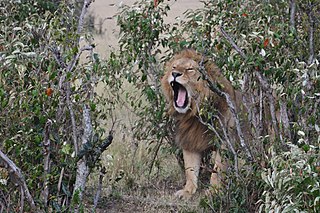
Nairobi National Park is a national park in Kenya that was established in 1946 about 7 km (4.3 mi) south of Nairobi. It is fenced on three sides, whereas the open southern boundary allows migrating wildlife to move between the park and the adjacent Kitengela plains. Herbivores gather in the park during the dry season. Nairobi National Park is negatively affected by increasing human and livestock populations, changing land use and poaching of wildlife. Despite its proximity to the city and its relative small size, it boasts a large and varied wildlife population, and is one of Kenya's most successful rhinoceros sanctuaries.
KwaZulu-Natal is one of the most diverse provinces in South Africa in terms of its fauna and flora. Many of its wide variety of ecosystems have been preserved as parks and reserves, which are popular tourist attractions. Ezemvelo KZN Wildlife is a governmental agency that maintains the wildlife conservation areas in the province.

Akagera National Park is a protected area in eastern Rwanda covering 1,122 km2 (433 sq mi) along the international border with Tanzania. It was founded in 1934 and includes savannah, montane and swamp habitats. The park is named for the Kagera River which flows along its eastern boundary feeding into Lake Ihema and several smaller lakes. The complex system of lakes and linking papyrus swamps makes up over a third of the park, which is the largest protected wetland in Eastern-Central Africa.
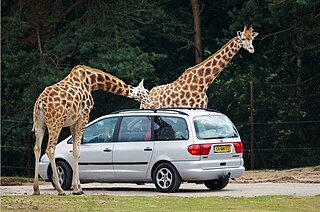
A safari park, sometimes known as a wildlife park, is a zoo-like commercial drive-in tourist attraction where visitors can drive their own vehicles or ride in vehicles provided by the facility to observe freely roaming animals.
Khutse Game Reserve is a game reserve in Botswana.

Mala Mala is a game reserve located within the Sabi Sand Game Reserve, Mpumalanga province, South Africa. It is the largest and the oldest private big five game reserve in South Africa, It covers around 130 km2 or 15 000 hectares of land. In Xitsonga, the name Malamala means Kudu, it was named so because of the abundance of these animals within the game reserve. The Tsonga people, who occupied the land before the establishment of the game reserve, were forcibly removed from this land during the early 1900s and were dumped at Bushbuckridge. The Nwandlamhlarhi Community successfully claimed Malamala game reserve and the land was restored to them in 2015 when President Jacob Zuma handed them their land in a Government ceremony. The Tsonga people were also forcibly removed from neighbouring game reserves such as Skukuza, Satara, Ulusaba, Manyeleti, Protea Hotel Kruger Gate, Hoyo Hoyo Tsonga Lodge and may more in Southern Kruger. The Tsonga people are still waiting to be given back these lands by the Government after the finalization of their land claim.
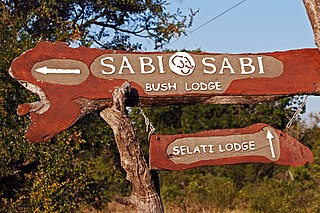
Sabi Sabi is a private game reserve in South Africa, situated in the Sabi Sand Game Reserve which flanks the south western section of the Kruger National Park. The Sabi Sand Reserve is one of the parks that make up the Greater Kruger National Park.
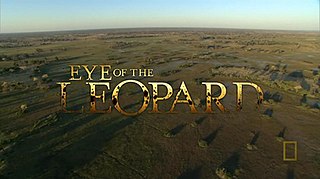
Eye of the Leopard is a 2006 National Geographic documentary directed by Dereck and Beverly Joubert. Set in the Mombo region of the Okavango Delta, Botswana, the film explores the life of a female leopard, Legadema, as she matures from a cub to an adult. Jeremy Irons, voice actor of Scar from Disney's 1994 animation The Lion King, narrates the film. It premiered in the US on the National Geographic Channel on October 8, 2006, and has won many awards including the BBC wildscreen Panda award for Best Sound Wild Screen and an Emmy. Since the success of the film, a book and an app of the same title have been released.

Federal Air is an airline headquartered at O. R. Tambo International Airport near Johannesburg, South Africa.
The Mara Triangle is the southwestern part of the Maasai Mara National Reserve, Kenya, and is managed by the not-for-profit organisation The Mara Conservancy on behalf of Trans-Mara County Council.
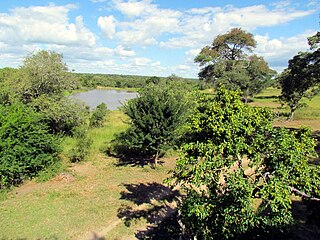
Djuma Game Reserve, is a 1,200 ha private game reserve, which is part of the Sabi Sand Game Reserve, Mpumalanga Province, South Africa. It is situated on the western border of the Kruger National Park, which together with some other parks make up the Greater Kruger National Park. The name Djuma refers to the roar of a lion.

Ulusaba Private Game Reserve, owned by Sir Richard Branson as part of the Virgin Limited Edition luxury property portfolio, consists of about 13,500 ha of land set in the heart of the Sabi Sand Private Game Reserve. This private game reserve borders on the sprawling Kruger National Park in South Africa's Mpumalanga province and is home to an abundance of wildlife. Ulusaba means fearful in the local Tsonga (Shangaan) language and it was a name given to the Sabie River by the Shangaan people. The Sabie River was originally called Ulusaba by the Shangaan simply because there was once a large concentration of dangerous Nile crocodile in the river. Before the establishment of the Kruger National Park, Ulusaba was once a home of Tsonga-Shangaan people, the Shangaan were evicted from this land when the Kruger National Park was established and were relocated in nearby villages adjacent Ulusaba Private Game Reserve.

The Great Rift: Africa's Wild Heart is a British nature documentary series, which began airing on BBC Two on 24 January 2010. A BBC/Animal Planet co-production, the three-part series focuses on the landscape and wildlife of the Great Rift Valley in East Africa. At the end of each fifty-minute episode, a ten-minute featurette, Inside The Great Rift, takes a behind-the-scenes look at the challenges of filming the series.

The SanWild Wildlife Sanctuary is a 5,000 ha (50 km2) wildlife rehabilitation center and reserve in South Africa's Limpopo Province, located a few kilometers south of Leydsdorp, and near the western boundary of the Kruger National Park.
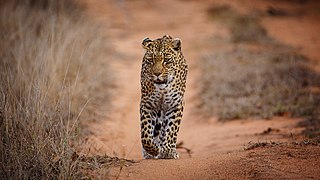
Sabi Sand Game Reserve is located adjacent to the Kruger National Park in the Lowveld of Mpumalanga, South Africa. Officially named Sabi Sand Wildtuin, the Sabi Sand Game Reserve consists of a group of private game reserves. The Newington Gate is at 24°52′9″S31°24′16″E and west of the Kruger Gate and Skukuza camp of Kruger Park. Other entrances are Gowrie Gate in the far north and Shaws Gate in the south.

Wild Earth is a safari video game and motion simulator ride by Super X Studios. The player photographs 30 types of animals as a photojournalist in Serengeti National Park. It was first released as an online video game in France on March 17, 2006, and in North America on April 24, 2006. Akella published the game for Microsoft Windows as Safari Photo Africa: Wild Earth on September 18, 2006, and Ubisoft published it as Wild Earth: Photo Safari in November 2006, while Xplosiv published it as Wild Earth: Africa on April 5, 2007. Majesco later published a Wii version, Wild Earth: African Safari, in 2008. The game was also installed as a motion simulator ride in multiple American zoos. It won several awards including the grand prize at the 2003 Independent Games Festival.
References
- ↑ "Djuma Game Reserve | Vuyatela | Galago Camp | African Safari Game Lodges, South Africa" . Retrieved 9 May 2020.
- ↑ Wild dogs, lions, elephants: See them roam from your computer – CNN Video , retrieved 9 May 2020
- ↑ Djunga, Heather (4 May 2020). "Go on safari at home with a twice-daily live-stream from South Africa". Washington Post. ISSN 0190-8286 . Retrieved 9 May 2020.
- ↑ "Virtual safari company sees huge increase in business after coronavirus lockdown". NBC News. Retrieved 11 June 2020.
- ↑ "Virus lockdown boosts South African virtual safari tours". sports.yahoo.com. Retrieved 11 June 2020.
- ↑ "Safaris go virtual as coronavirus hits tourism". BBC News. Retrieved 10 June 2020.
- ↑ "Luxury African Safaris | South America & Asia Tours | andBeyond". Luxury African Safaris,South America & South Asia Tours|andBeyond. Retrieved 10 June 2020.
- ↑ "andBeyond Ngala Safari Lodge | Kruger | Big Five | South Africa". Luxury African Safaris,South America & South Asia Tours|andBeyond. Retrieved 10 June 2020.
- ↑ "&Beyond Phinda Private Game Reserve | South Africa | andBeyond". Luxury African Safaris,South America & South Asia Tours|andBeyond. Retrieved 10 June 2020.
- ↑ "WILDwatch Live | Daily Live Stream Safaris from &Beyond and WildEarth". Luxury African Safaris,South America & South Asia Tours|andBeyond. Retrieved 9 May 2020.
- ↑ "EcoTraining – Guides & Guardians – FGASA Accredited Training Courses". EcoTraining. Retrieved 9 May 2020.
- ↑ "Karongwe Portfolio – safari lodges near Kruger National Park" . Retrieved 10 June 2020.
- ↑ Peter. "WildEarth to stop broadcasting from Karongwe – Graham to hold town hall after the Sunset Drive". WildEarth. Retrieved 10 May 2020.
- ↑ "Tswalu – Private Game Reserve in Northern Cape". Tswalu. Retrieved 10 June 2020.
- ↑ "Safari Live SABC3". SABC3.
- ↑ "WildEarth channel on XUMO". 21 July 2021.
- ↑ "Insidus: Roundups #41: WildEarth TV Now Available on Plex and Rad NFTV, Maya Erskine Joins Donald Glover in 'Mr. And MRS. Smith' Series at Amazon and Botched Season 7B Launches on E! Africa". 15 April 2022.
- ↑ "WildEarth – YouTube". www.youtube.com. Retrieved 28 August 2020.
- ↑ "Djuma Private Game Reserve – YouTube". www.youtube.com. Retrieved 28 August 2020.
- ↑ WildEarth, Blogger. "Rhinos Return to Your Screen!". WildEarth. Retrieved 12 January 2023.
- ↑ Pavid, Louise. "Character Feature: Djuma Clan". WildEarth. Retrieved 28 August 2020.
- ↑ Peter. "It's time to name the hyena cubs". WildEarth. Retrieved 28 August 2020.
- ↑ "leopard – WildEarth". wildearth.tv. Retrieved 28 August 2020.